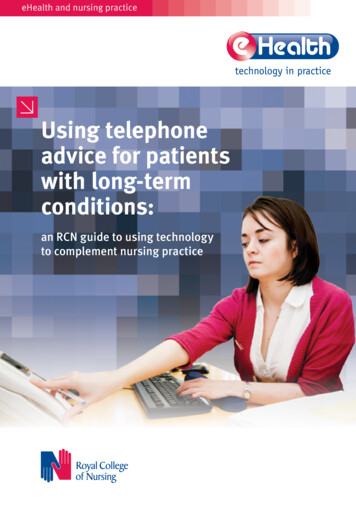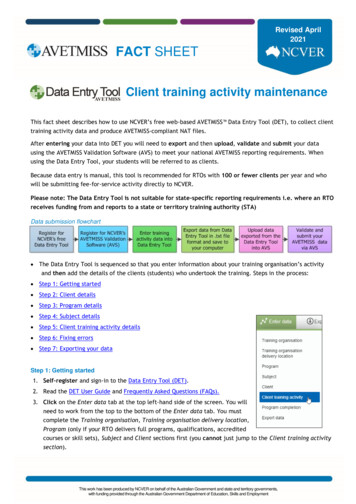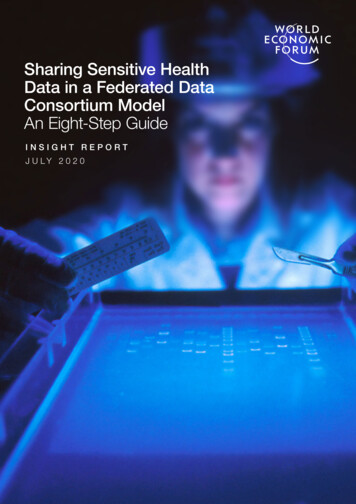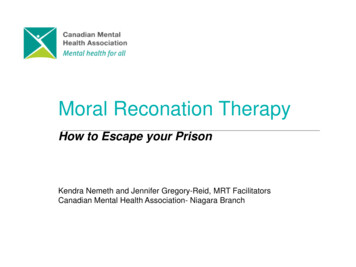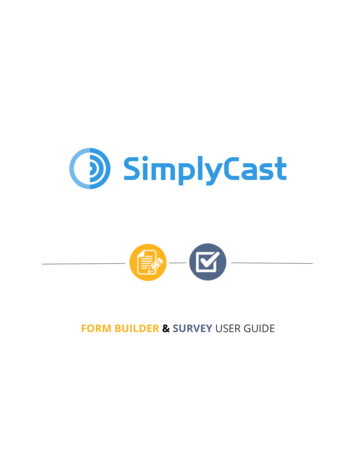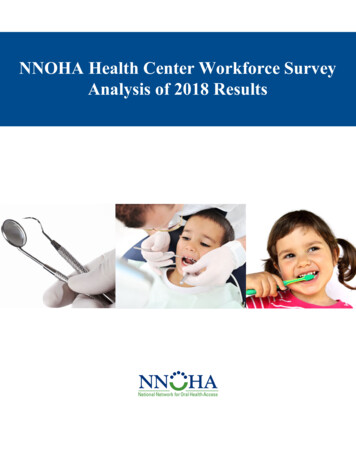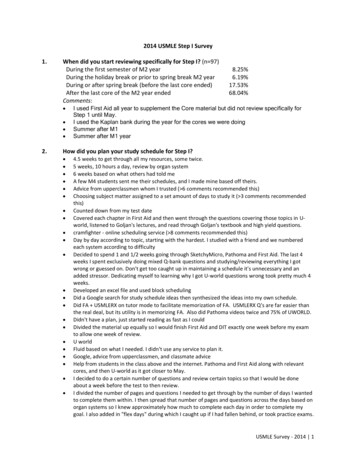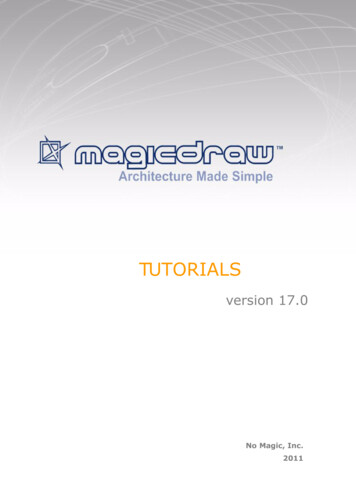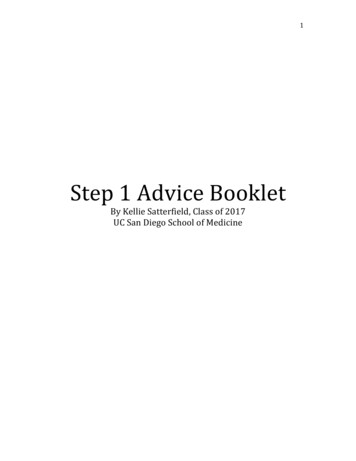
Transcription
1Step 1 Advice BookletBy Kellie Satterfield, Class of 2017UC San Diego School of Medicine
2Survey Data Collected: 2/2017Booklet Created: 3/2017
3Table of ContentsIntroduction.4Step 1 Resources.7Resource Opinions.10First Aid for the USMLE.10Doctors in Training Full Review Course.13Doctors in Training Videos Only.14UWORLD Qbank.15Kaplan Qbank.19USMLE-Rx.19Pathoma.20Sketchy Micro/Medical.23Picmonic.26BRS (Board Review Series).26Goljan Audio Series.27Goljan Rapid Review of Pathology.28Anki 1Lange Pharmacology Flashcards.32Course Materials.32Other Study Resources / Strategies.33Practice Exams.35Prometric Center Practice Exam.35NBME.37UWORLD, In-Depth.42Second Year Planning.56Vacation, Scheduling Step 1, and When to Start.61Study Schedules, Tips, and the Test Day.65Moving Your Test Date.84Well Being and Mental Health.88Mental Breakdowns.88Acknowledgements.100Summary.101
4IntroductionThe purpose of the Step 1 Advice Survey was to collect anonymous informationfrom current UCSD medical students who had completed the USMLE Step 1examination. The survey aimed to ascertain various Step 1 study habits andresulting trends for the purposes of medical education quality improvement. Thegoal was to help better inform future medical students on what study tools/habitshave been used in the past and what had worked for students, and to highlight anydiscovered correlations or significant findings. This survey will also help to informthe administration on student needs.The results of this survey have been complied into booklet format to be distributedannually to second year medical students. This will hopefully reduce studentanxiety, improve preparedness, and increase Step 1 scores.This survey does not have IRB approval. It was collected for the sole purpose ofquality improvement. No identifying information was collected. To qualify to havetaken the survey, students needed to be a current UCSD medical student and havealso completed the USMLE Step 1 Licensing examination.One hundred current UCSD medical students completed the ‘Step 1 Advice Survey’.Of those, 38 were current third year students and 62 fourth year students. Moststudents found preparing for Step 1 to be very-extremely stressful (Figure 1). It wasfound that there was a moderately positive correlation between individual Step 1score goals and Step 1 scores, (R2 .513, Figure 2), meaning that the higher thestudents step 1 goal, the more likely they were to achieve a higher score. Despitethis, 31% of students were not satisfied with their Step 1 scores (Figure 3). Therewas also a moderately positive correlation between MCAT scores and Step 1 scores;however, the factors that contributed to this relationship were not investigated(Figure 4). Lastly, there was a moderately positive correlation between exam scoresduring first and second year of medical school and Step 1 scores (R2 .37, Figure 5).
5Figure 1.Number of Students (n)Student Stress Regarding Preparing to Study for Step 1:4030201001Not Stressful2345ExtremelyStressfulStressfulness RatingFigure 2.Of@icial Step 1 Score Against Step 1 Goal:280Of@icial Step 1 Score270R² 0.51256260250240230Ofjicial Step 1 Score220Linear (Ofjicial Step 1Score)210200190190 200 210 220 230 240 250 260 270 280Step 1 Score GoalFigure 3.Student Satisfaction with Their Step 1 Score:Not Satisjied31%Satisjied69%
6Figure 4.Step 1 Score Against MCAT Score:280270R² 0.28092Step 1 Score260250240230220Step 1 Score210Linear (Step 1 Score)20019025 26 27 28 29 30 31 32 33 34 35 36 37 38 39 40 41 42 43MCAT ScoreFigure 5.Step 1 Score Against MS1 and MS2 Exam Average280Step 1 Score270Linear (Step 1 Score)260R² 0.37163Step 1 99%MS1 and MS2 Exam Average
7Step 1 ResourcesMany resources can be used to prepare for Step 1. Some resources were preferredduring the year and others during the dedicated study period. The most commonresources used were First Aid For the USMLE and UWORLD Qbank, both with at99% of students surveyed having used those resources (Figure 6). The next mostcommon resources used were Pathoma (85%), Sketchy Medical (76%) and theNBME Practice exams (75%). Other notable resources include Anki flashcards, theGoljan Audio Series (Podcasts), USMLE-Rx Qbank, Doctors in Training Videos andcourse materials from the first two years of medical school.Figure 6.% of Students UsedResources Used:1009080706050403020100
8Surveyed students rated each resource (only if they used that resource) from notimportant at all (score of 1) to extremely important (score of 5), (Figure 7).UWORLD Qbank was found to be significantly rated as the single-most importantresource with the narrowest 95% confidence interval (Avg 4.95, CI 4.88-5.01). Otherresources with confidence intervals falling in the rated ‘very important’ to‘extremely important’ range, in order of average rated importance, include FirstAide for the USMLE (Avg 4.55), Sketchy Medical (Avg 4.46), Anki Flashcards (Avg3.88), Pathoma (Avg 4.3), NBME Practice Exams (Avg 3.88), Doctors in Training FullReview Course (3.88), and Cram Fighter (Avg 3.67). BRS, Firecracker, and Osmosiswere found to be the least important resources, with averages of 2.5, 2.44, and 2.0,respectively. Rated importance is also displayed by percentage, based off thenumber of students who used the resource (Figure 8). Lastly, the number ofresources used did not seem to positively or negatively impact score (Figure 9).Figure 7.Average Rated Resource Importance:First Aid For the USMLEDoctors in Training Full Review CourseDoctors in Training Videos OnlyUWORLD QbankKaplan QbankUSMLE-Rx (First Aid Qbank)NBME Full Practice ExamsPathomaSketchy Micro / MedicalPicmonicBRS books (Board Review Series)Goljan Audio Series (Podcasts)Goljan Rapid Review of PathologyAnki FlashcardsFirecrackerOsmosisCram FighterLange Pharmacology FlashcardsCourse Materials01Not2Slightly3Moderately4Very5Extremely
9Figure 8.Percentage of Users(%)Rated Important of Each Resource:100%90%80%70%60%50%40%30%20%10%0%Not at ryImportantExtremelyImportantFigure 9.Step 1 Score by Number of Resources:280Ofjicial Step 1Score270Step 1 Score260250240R² 0.003012302202102001902345678Number of Resources9101112
10Resource OpinionsStudents were asked to give free-form feedback on each study resource used, andthe feedback was then reviewed, spelling was checked and grammar corrected, andinappropriate or ‘n/a’ comments were removed. Recurrent themes and/or keypoints the author found relevant or helpful were bolded below.First Aide for the USMLE:Most students felt this was a vital resource, some got it unbound, many wrote notesin the book’s margins. Many felt that this was a better to use as an outline, forreference, graphs, mnemonics, and quick facts, rather than something to study fromdirectly; however, others used it as their primary guide. Most found this resource tobe worth the money.Must haveMust haveRead a portion each day, annotated with other study materialsReference and notes in the margins. Worth the money.I used this as my main resource, and would add handwritten notes form other resources into firstaid. I would read a designated chapter each morning for a few hours and then do UWORLDquestions. I probably read the entire book at least 3 times.Read through the whole thing. Great succinct resource. Worth it.Only used for lists e.g. CYP450 inhibitors or toxins and antidotes. Otherwise it was difficult to studyfrom.I used it as a reference/to get good mnemonics. I didn't find it super helpful though.Adjuvant to UWorld, I used it as a reference for topics I got wrong on UWorld.Annotated, using Kaplan review videos, definitely worth the money.Worth the money.Took notes throughout 2nd year classes in the book and while reviewing UWorld questions. Worththe money.Used daily and sequentially.Used it as my "Bible" for all notes. I read through FA and highlighted key points. I also took notesfrom other resources into FA so I would have everything in one place. I reviewed the high-yieldsection immediately before taking Step 1.As a "textbook" to review many basic conceptsHelpful for supplementing UWorld as provides fairly comprehensive reviewMemorized every word of this -- by far the most important part of my studying.I read it cover to cover, highlighted, used flags. FA is passive learning, so it shouldn't be a first-lineresource. It's good in that it touches on all the major areas to know, but basically was just bulleted
11outlines with hit-or-miss mnemonics. Felt like I wasted a lot of time on FA that should have beenspent on UW.I unbound this and took the small sections to study during the relevant blocks during the year. Ialso wrote my Pathoma notes down in first aide so that I would have all my notes togetherI used it for the purpose of synthesizing information from various other resources (e.g. Pathoma,DIT, etc.). I actually really didn't enjoy "studying" from FA, but it is excellent for note taking.Used as a guide during lectures. Tried to reference lecture material with FA and read FA inconjunction with lectures. Great resource for bullet-point type info, but does not really "teach".A must-have, annotate as you go along.Kind of a "home base " for studying. Went through it a total of 3 times and reviewed missed andchallenging practice questions in first aid.I split up my "study days" by chapter of First Aid, and would try to spend a few days on eachchapter really learning the material.Good for review. Needed.Went through this with the DIT videos and annotated. Then re-read the whole book and the notes.I used it to study during the first two years, and I used during devoted study time. It's essential.Excellent resource, I did 2-3 passes of this book while I was using other resources like UWorld andSketchy Micro to complement First Aid's material and annotated my textbook so that this was mycentral study guide.Used by reading, following along with USMLE-RX, and by annotating in the book.Critical, this was the framework on which I organized material in my mind.Read, highlighted and annotated every page of the book. This is the golden resource that has almosteverything you will ever need to know. Absolutely worth the money. Did a second and a VERYcursory third pass of the book prior to the test.Helpful but not enough detail/explanation by itself (for my style).Good for reference. Wasn't able to read/study from.Read through book 2x.100% necessary. I used it to take notes while using other resources (DIT, UWorld, Pathoma). Theweek before the exam, I split up FA into 5 sections and tried to review a section per day so I could seeeverything one more time. Turned out to be overly stressful but I think it helped somewhat.I read through the book. Then referred back to it as needed when doing UWORLD.Reviewed subjects as we went through them during second year. Used as reference during UWorldquizzes.Supplemental information on specific topics, usually related to a UWorld question.Great for structuring the overall study period. Would often combine a First Aid chapter (e.g.cardio) with a selected block of UWorld questions on tutor mode (e.g. also cardio). This wasdefinitely worth the money. However, simply reading chapter after chapter, without combining itwith note taking and Qbanks, would be unwise.General Overview.Master reference of all info I had compiled. Broke it into a binder and added pages and wrote allover it.Primary resource. Provides an outline for what needs to be covered during your Step 1 study.Highlights zebras. Still need to do extensive practice questions in order to be able to apply theknowledge.
12I used this as my primary study tool to organize my time and the material I was covering. I brokemy days up into organ systems largely dictated by First Aid and then would use supplementalmaterials to reinforce the material I was learning in there. As someone who writes in books a greatdeal, I appreciated that the company thought about the quality of the pages in the book so that itdidn't bleed through too much. I definitely think the resource was worth the money.Worth it. Great review of almost everything, but does leave some gaps that need to be filled withmore detail. Should be sure to branch out if noticing weaknesses on Qbank questions.I compiled all my notes from UWorld, Rapid Review, and Pathoma into my First Aid book. My first aidbook held all the information I needed for Step 1.Loved it. Totally critical to studying. It was my bible. I unbound it and I put all notes and annotationsfrom all other resources into First Aid.Great, only a bare bones set of notes, need more thorough understanding for it to click.Important but pretty dense. I'd go through this twice but do the first pass well ahead of yourdedicated study time and use the second pass to focus on sections you are struggling with.Used notability to annotate it electronically so I could always have it with me. I annotated all otherresources into First AidRead twice, made flash cardsRead 2x prior to dedicated study (low yield, don’t really recommend) and read at the end ofdedicated with all my UWorld annotations (more useful).Outline.I read through First Aid TWICE. VERY IMPORTANT RESOURCE.Used with courses to make sure I was hitting on high yield points as I studiedLoved it, worth the money.Great resource to use in conjunction with PathomaUsed it as the skeleton for my studying, just learning the basics, for reference.Not much to say, it has its reputation for a reason.Used it with the Rx videos that walked you through the book which I founds super helpful. I alsoannotated the book based off UWorld so it was basically like my bible of everything I knew/wasstudying. Work it.Took notes from DIT videos in first aid and read through it 2-3x before examRead it, concise.Worth it for organization.Refer to it while going over UWorld questions.I used this as the main focus of my studying. I would cover one subject every 2-3 days and madeflashcards by hand for all the topics.For general information/organization and introduction to each subject, a place to annotate, and forrapid review at the end.Annotated Pathoma in it. Go through each organ system, made sure I understood everything, tried tomemorize what I didn't know. Used Picmonic for stuff I had trouble memorizing without it. UsedSketchy Medical/Picmonic for the pharm section in FA. Skipped FA micro chapter and only didsketchy micro.I had an electronic copy of First Aid which I used alongside my organ system courses in MS2 tofigure out which points that we were learning were important to remember for step 1, which pointswe were not learning that were important for step 1 (i.e. I should try to learn these on my own as we
13go), and which points I may need to know for my block exam but could forget afterward (i.e. I wouldnot put them in my step 1 Anki deck). I also used First Aid this as a reference for reviewing missedQbank questions. I also used the diagrams and figures on the backs of my Anki cards asappropriate. I did NOT ever try to make a complete pass through first aid or read it like a textbook.In fact, my paper copy of First Aid got more use as a step stool or a block to elevate my computermonitor than as a textbook. The searchable pdf was used far more frequently.Wrote notes from DIT videos in the margins and cross-referenced. I used this because it was the #1recommended resource, but I actually didn't like it very much; it was too "bare bones" for me,difficult to get through without some form of guidance (which is why I used DIT videos).Read the entire thing once, highlighting as I went, good for reference.Barely used at all, I hated the format.Notes, review, talking through it with classmates or myself.Reference during studying; not primary study tool.Useful and worth the money. Not good for primary studying. Good as a final review before test.Main book/resource I used.Great.Unbound, annotated every page and inserted my own notes; loved it as a study guideline, but wasnot as detailed as necessary.Some pathology review.Good for tables and condensing all the information into one place. However, not good for learningmaterial.I couldn't memorize from this format, so it was useful to use it as referenceMost important resource has all the information but needs to be supplemented with a question bank.Great for content review.Went through it twice, memorized it cover to cover.Liked it for some diagrams and quick facts but found it hard to read as a stand alone due to howabbreviated the text was.Made an outline from the book that I reviewed. Definitely worth the .Must use.Definitely better to try and use as needed, when you get something wrong in UWorld, etc. and need aquick reference. Not as great if you just try to read through it.Read it with each block. Read it again during dedicated study period. Read it again with 1 week to gobefore test. Took all my UWorld notes in it.Read through it with DIT and then separately (with notes from DIT). Worth the money. Love theillustrations. Nothing that I don't like about it.Excellent.Reference.Doctors in Training (Full Review Course):Fewer students used the full DIT review course, compared to just the DIT videosalone. Those that did, however, liked the structure and how thorough the course
14was. Drawbacks include cost and length of time it takes to complete the course. Formore DIT information, please see DIT videos only summary.The videos were solid and engaging. Definitely helped me with structuring my study plan andmaking sure I got through "all" the material. I used this resource pretty heavily in the 6 weeks leadingup to the test. It also references FA throughout the review book/videos, so it's not an entirely"separate resource" in that regard. The drawback is that DIT takes a lot of time. I would spentabout 6 hours during the day getting through the DIT videos on average, which left me with 2-4hours of time for U World before I burned out. I think in hindsight I probably spent too much time onDIT and not enough time on U World questions and practice tests during the last 4 to 6 weeks ofstudy time. If you are the kind of person that needs structure, DIT may be for you. DIT will almostcertainly get you a solid score (230s to low 240s; I think the average DIT user gets around a 235),but if you really want to excel, you need more time on practice questions. If you are going to do DIT, Iwould recommend rationing a couple of extra weeks either prior to or during the "study weeks"during which you use U World heavily and exclusively.LOVE IT! This got me through my studying.Very time consuming. It didn't feel worth it to me.Very helpful, kept me on track and reviewed First Aid in more detailed; I personally thought it wasworth the money because I liked having the schedule and the interactive study options not justreadingLearning material in a compact way.I advise against.Doctors in Training (Videos Only):Students really liked this resource because of its structure and organization. Thisresource seemed best suited to audio/visual learners as well. Students also liked touse the resource selectively to get a better understanding of a certain subject suchas biochem or metabolism. Students disliked this resource for the length of time ittook to get through the videos and for the price; however, many students pirated thevideos so this resource was not cost prohibitive.Watched each day. I pirated them, so it was not cost prohibitive.I used it to listen while running/driving/working out etc. I had pirated version, so yes worth themoney.It was helpful at explaining physiological concepts, but I would not have paid full price for it.I used this to do structured "in-depth" review prior to the examThis was a key resource for me because I would get too board only reading. It did seem silly atfirst needing someone to basically walk you through first aid but this was such a nice way to breakup the day and study in a different way. I also loved their little quizzes at the start and end of thevideos. I thought they also had super helpful charts/graphs and mnemonics not offered in firstaid that were clutch on my test day - especially the p450 inducers and inhibitors and bone tumors.HIGHLY RECOMMEND!
15I used this resource primarily for studying for Biochem (which is not taught at UCSD). I found therepetition and question/answer format in each video extremely helpful. Paired withBrosencephalon Anki questions, I felt like this was a good method of quickly learning things as anaudiovisual learner.I would watch these as I was studying a chapter of first aid, because they basically explain first aid toyou. Not sure how helpful this was - it is super time consuming.Pretty good. Not worth .Mostly helpful in pacing yourself early on. Doesn't contain too much information that first-aid doesn'tbut it helps break up your day from just reading all day long to chunks of more active listeningand taking notes. Used videos to guide my first pass of first-aid to keep me on track.Watched downloaded videos for topics I struggled to grasp.Expensive, but very thorough and well-organized set of videos. I used it at the start of studying andit gave me a solid foundation. I think it's worth it if you can split the cost among a few people.Study aid when I needed structure.Expensive, but worth the money. Far and away the best single resource.I watch all of the videos and annotated first aid.I watched all of these videos and annotated First Aid the first time through.Used at the end for particularly tough subjects like Biochem.I felt I counted on these videos to teach me what I needed to know but it was more passive ratherthan active learning and took a lot of time that I think may have better spent on other resources.Overall not worth the money. Some useful mnemonics!Watched some, good teachers.Used to go over videos sometimes.I watched less than 5 of these videos on specific concepts of metabolism where I felt like I needed arefresher. They were ok.Lots of good mnemonics and helped in getting through First Aid. They also included topics thatwere not covered in FA. If I had to redo that torturous period of my life, I don't think I would usethese again, or rather, I would choose to use them for a few topics that I really struggled with (i.e.biochem).Good for physiology review.I used them for free, hence worth the money. I liked that it forced me to get through a section ofFirst Aid though I'm not sure how effective it was for me to actually retain the material. I took notesfrom DIT onto first aid. I think it took a lot of time that in retrospect would have better served me ona 2nd pass through UWorld.UWorld Qbank:Students feel that UWorld Qbank is unanimously the best Qbank available and alsothe single best resource. Some students wished they had started doing UWorldquestions earlier in the year or just more overall. Students were in agreement thatthis resource is worth the cost. Many students emphasized that it is important toread all of the answer explanations. *Please see the UWorld section for more indepth UWorld information.
16Must haveDid blocks of questions each day. Probably my most important studying. Worth every penny.My main source of studying. I would just sit down and do a couple hundred questions a day andreview things I wasn't clear on.I did all questions, starting at 40 a day and then up to 200 a day the week or two prior to my exam.Reviewing the questions is extremely important, as is repeating questions you got wrong. Iwent through the entire question bank about 1.5 timesBest way for me to learn because of Q&A.Used this as my main study source.Worth the money for the whole year.I wish I had done this way more.Went through subjects on timed mode during the block we were studying, and reviewed all incorrectresponses as well. Then reset the Qbank and went through them all randomly and did all incorrect aswell. Sometimes did subject focused if still having problems in that area.UWorld comprised 3/4 of my study day.Completely worth it.Most helpful resource.Another way to learn concepts; best way to practice test takingBest resource. Highly recommend.Did all of
Lange Pharmacology Flashcards Course Materials 9 Figure 8. Figure 9. 0% 10% 20% 30% 40% 50% 60% 70% 80% 90% 100% s ) Rated Important of Each Resource: Not at all Important Slightly Important Moderately Important Very Important Extremely I
